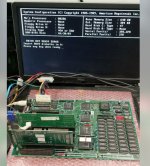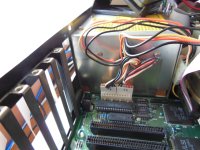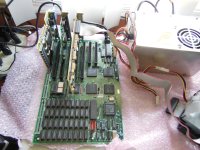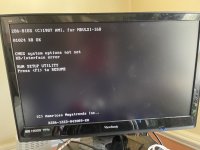alejack12001
Experienced Member
I am using an unbranded 286 motherboard that I recently acquired for an IBM 5162 machine to replace an AST motherboard that was faulty. The AST board worked with a 130-W power supply that accompanied the 5162 received. Power supply was good at least under the AST board.
The attached picture, labeled DSC0002.JPG, shows the motherboard that was sold to me by an eBay seller. If you notice, the sellers power supply that was used to demonstrate the actions of the board as being operational, was a converted 20-pin to 12-pin supply to power the board during this demo less a chassis ground to the board other then the grounds through of the power connector.
The problem is when I flip on the 5160’s 130-W Power Supply power switch, the board doesn’t respond. The fan, which is on top of the power supply doesn’t spin up. First, I thought it was a grounding issue since the seller didn’t have a chassis ground and I did have a chassis ground with a screw seen in picture DSCN0034.JPG. I checked the board using a continuity checker on my DVM and removed the screw anchoring the board to the chassis as well as removed the power connectors and then checked ground points I could find such as the ROM’s. I found that no chassis grounds were detected. When I reconnected the power connectors a ground reappeared. I have ruled out a grounding issue.
I don’t know if there is a fuse in this power supply or not. No schematic on this supply except for one posted on minuszerodegrees.org website. The posted power supply schematic didn’t show one and I am unsure how true to form the 5160 power supply that I have matches the actual 5160 shown on the website.
I was going to reproduce the setup that the seller tried to see if the board and power supply responds. This will prove a possible short between the board and chassis. I have the board raised on those nylon stands for most of the holes in the board. The next picture shows the same board in the 5160 case, labeled DSCN0034.JPG. I have a case connected screw that is shown near the power supply connection.
I am looking for advice and other users experiences here. I know there is multiple power supply threads on the forum with some match and many others that are similar, but with different platforms.


The attached picture, labeled DSC0002.JPG, shows the motherboard that was sold to me by an eBay seller. If you notice, the sellers power supply that was used to demonstrate the actions of the board as being operational, was a converted 20-pin to 12-pin supply to power the board during this demo less a chassis ground to the board other then the grounds through of the power connector.
The problem is when I flip on the 5160’s 130-W Power Supply power switch, the board doesn’t respond. The fan, which is on top of the power supply doesn’t spin up. First, I thought it was a grounding issue since the seller didn’t have a chassis ground and I did have a chassis ground with a screw seen in picture DSCN0034.JPG. I checked the board using a continuity checker on my DVM and removed the screw anchoring the board to the chassis as well as removed the power connectors and then checked ground points I could find such as the ROM’s. I found that no chassis grounds were detected. When I reconnected the power connectors a ground reappeared. I have ruled out a grounding issue.
I don’t know if there is a fuse in this power supply or not. No schematic on this supply except for one posted on minuszerodegrees.org website. The posted power supply schematic didn’t show one and I am unsure how true to form the 5160 power supply that I have matches the actual 5160 shown on the website.
I was going to reproduce the setup that the seller tried to see if the board and power supply responds. This will prove a possible short between the board and chassis. I have the board raised on those nylon stands for most of the holes in the board. The next picture shows the same board in the 5160 case, labeled DSCN0034.JPG. I have a case connected screw that is shown near the power supply connection.
I am looking for advice and other users experiences here. I know there is multiple power supply threads on the forum with some match and many others that are similar, but with different platforms.




